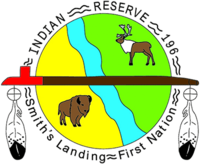Smith's Landing First Nation
 | |
| People | Dënesųłı̨né |
|---|---|
| Treaty | Treaty 8 |
| Headquarters | Fort Smith |
| Territory | Northwest Territories |
| Land | |
| Reserve(s) | |
| Land area | 100.497 km2 |
| Population (2019) | |
| On reserve | 163 |
| Off reserve | 204 |
| Total population | 367 |
| Government | |
| Chief | Thaidene Paulette |
| Council size | 5 |
| Tribal Council | |
| Akaitcho Territory Government | |
| Website | |
| slfn196.com | |
Smith's Landing First Nation (Chipewyan: Tthëbátthı́ dënesųłı̨ne) is a band government headquartered at Fort Smith, Northwest Territories, Canada.[1] Members of the band call themselves, in the Dene Suline language, the Thebati Dene Suhne.[2]
The film Honor of the Crown, directed by Tom Radford, documents the Thebatthi (Chipeweyan) people's successful battle to get the Canadian government to honor its obligations according to an 1899 treaty.[3] Led by François Paulette and his brother Chief Jerry Paulette, the band reclaimed nine tracts of land and $33 million in compensation, becoming Alberta's 44th First Nation.[3]
In June 21, 2024, Smith's Landing First Nation signed a memorandum of agreement to collaborate with three other Fort Smith governments in improving the lives of constituents, as part of the Collaborative Leadership Initiative (CLI).[4]
Indian reserves
[edit]The band has ten reserves located in Alberta. These are:[citation needed]
- Ɂejëre Kʼelnı Kuę́ 196I (Hay Camp)
- Hokédhe Kué 196E (Myers Lake)
- Kʼı Kué 196D (Birch Lake)
- Łı̨ Dezé 196C (Dog River)
- Tthebacha Náre 196A (Border Town)
- Tthebatthıe 196 (Fort Fitzgerald)
- Tsʼu Kʼadhe Kué 196F (Leland Lake)
- Tsʼu Nedhé 196H (Pine Lake)
- Tsʼu Kué 196G (Charles Lake)
- Tthejëre Ghaı̨lı̨ 196B (Salt River)
- Tsʼu Kué 196G is an Indian reserve of the Smith's Landing First Nation in Alberta, located within the Regional Municipality of Wood Buffalo.
References
[edit]- ^ "Smith's Landing First Nation". Treaty 8 Urban Child and Family Services. Retrieved 21 July 2024.
- ^ "Smith's Landing First Nation". Native Ministries International. Retrieved 21 July 2024.
- ^ a b "National film board release highlights Alberta First Nation". Windspeaker. Vol. 19, no. 11. March 2002. p. 26. Retrieved 21 July 2024 – via EBSCOHost.
- ^ Taylor, Tom (3 July 2024). "Four Fort Smith governments commit to collaboration under new deal: 'The governments above us are broke. Nobody's coming to save us,' says project lead Michael Miltenberger". The Hub. Retrieved 21 July 2024 – via ProQuest.
